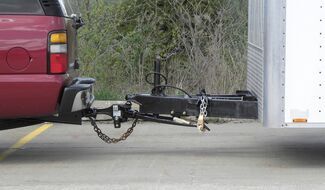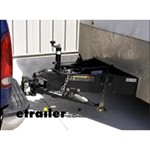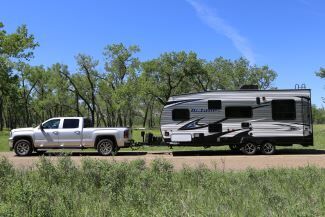
Towing capacity of a 2014 Ford F-150 4x4 SuperCrew 145 Inch Wheelbase 3.5L EcoBoost 3.55 Rear End
Question:
I just bought a 2014 f150 4x4 super crew 3.5 V6 Eco boost 3.55 axle ratio 145inch Wb, 7200# GVWR package. It is supposed to tow 9,600 lbs according to the ford dealership and paperwork. I have a 2015 Titan two horse slant trailer I just bought that weighs 2810 lbs. I hooked the empty trailer up to my hitch on my truck currently 3 1/4inch drop and my truck sank almost 6 inches. I Couldnt even move the cinder block out from under the trailer. I wondered if it could be the wrong hitch or I needed a shorter drop. Before I buy a new hitch or worry I bought the wrong truck to pull this trailer. The tongue on the trailer says RAM USE 2inch Ball only 7000# capacity. The sticker on my truck door says Front GAWR 3750lb, rear GAWR 3850lb, the combine weight of occupants and cargo should never exceed 1361lbs.inch The hitch sticker makes it even more confusing for me because it says 10,500 which isnt a number I had been told. I was told 5000 from the bumper and 9600 from the hitch. Im concerned that I cant put two horses in my trailer and pull it with a normal hitch as it will be over 5000 pounds. One person suggested that I cant pull this trailer without a weight distributing hitch. Please tell me what you think I need. Thank you.
asked by: Rebecca G
Expert Reply:
I looked up the owners manual for the 2014 Ford F-150. On a 4x4 SuperCrew with the 3.5 liter EcoBoost, 145 inch wheelbase, and 3.55 rear end the gross combined weight rating will either by 13,400 pounds (for limited models) or 15,500 pounds. If you subtract the gross vehicle weight rating of 7,200 pounds then the max you can tow will either be 6,200 pounds or 8,300 pounds. Of course if the gross weight of the truck when loaded with cargo, fuel, and occupants is only 6,000 pounds then you could tow a heavier trailer.
I am not sure where the 9,600 pounds comes into play so I would have a Ford technician, not a salesman, explain it because there may be some factor I am missing. It is likely though that to reach that upper limit you would need to use weight distribution which would also help with the rear end sag.
You mentioned that the trailer, when you hooked it up empty, weighed 2,810 pounds. At the typical 10 to 15 percent the tongue weight would be 281 to 422 pounds. At the upper end I would expect some sag but not 6 inches! That is major sag. Where you on level ground, pavement or concrete? If not that could be the reason it aged or appeared to sag so much.
If the trailer was tilted down at front when connected then the tongue weight was likely much higher and that could be a factor too. You do want to tow the trailer level. I have included a link to a help article that explains how to measure for rise or drop.
Until a Ford tech can explain that 9,600 pounds I would say it is safe to tow 6,200 pounds for sure. I don't know what the average horse weighs (I'm sure a Clydesdale weighs more than a Kentucky Saddler) but if they are small horses that temporary 6,200 pound limit may be enough.
So, first thing to figure out is what the truck is actually rated for and an explanation of why it is that way. Second, since the hitch says that you need weight distribution for a trailer over 5,000 pounds then you need to follow that.
To choose a weight distribution system you will need to go by the total tongue weight of the set up. This is calculated by taking the tongue weight of the trailer, when loaded and ready to tow, and adding to that the weight of anything loaded behind the rear axle of the tow vehicle. If you can give me all that information I can set you up with what you need.

Product Page this Question was Asked From
Curt Trailer Hitch Receiver - Custom Fit - Class IV - 2"
- Trailer Hitch
- Custom Fit Hitch
- Class IV
- 1000 lbs TW
- 10000 lbs GTW
- 12000 lbs WD GTW
- 2 Inch Hitch
- 1200 lbs WD TW
- Visible Cross Tube
- CURT
more information >
Featured Help Information
Instructions
Miscellaneous Media

Continue Researching
- Shop: Suspension Enhancement
- Q&A: Towing Capacity of a 2014 Ford F-150 4x4 with 5.0 Liter Motor
- Shop: Trailer Hitch
- Search Results: dx35fr
- Shop: RoadActive Suspension Custom Leaf Spring Enhancement Kit - Heavy Duty
- Q&A: Towing Capacity for a 2014 Ford F-150 Ecoboost
- Shop: Trailer Wiring
- Search Results: 205/65r15
- Shop: Towing Mirrors
- Shop: Brake Controller
- Shop: Vehicle Sway Bars
- Shop: Aluminum Liger Trailer Wheel - 16" x 6" Rim - 8 on 6-1/2 - Glossy Black
- Shop: Lionshead Trailer Wheel Center Cap - 4.88" to 4.9" Pilot - Stainless Steel - Qty 1
- Shop: Chrome Trailer Wheel Lug Nut - 1/2" - Qty 1
- Video: Trailer Hitch Installation - 2014 Toyota Sienna - Draw-Tite
- Shop: Curt T-Connector Vehicle Wiring Harness with 4-Pole Flat Trailer Connector
- Shop: Draw-Tite Max-Frame Trailer Hitch Receiver - Custom Fit - Class III - 2"
- Shop: Curt Trailer Hitch Receiver - Custom Fit - Class III - 2"
- Shop: Air Filter
- Search Results: 16" trailer wheel
- Search Results: 1 2 20 lug nuts
- Search Results: 1 2 x 20 lug nuts
- Search Results: lynx trailer wheel
- Search Results: 12
- Q&A: RoadActive Suspension Heavy Duty Versus Standard Duty
- Q&A: Standard or Heavy Duty RoadActive Suspension for 2020 Ford F-150 With 2-Wheel Drive
- Article: Determining Trailer Tongue Weight
- Article: Stability Control for Heavy Duty Vehicles
- Article: 5 Things to Know About Weight Distribution Hitches
- Video: etrailer Campers and Utility Trailers Tongue Weight Scale Review































